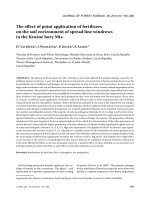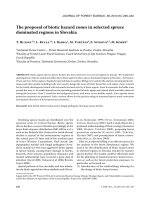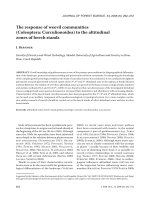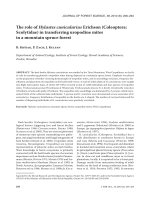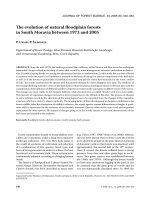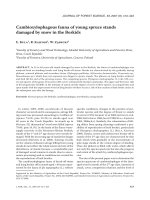Báo cáo lâm nghiệp: " The use of ultrasonic detectors for water stress determination in fruit trees" docx
Bạn đang xem bản rút gọn của tài liệu. Xem và tải ngay bản đầy đủ của tài liệu tại đây (120.73 KB, 4 trang )
The
use
of
ultrasonic
detectors
for
water
stress
determination
in
fruit
trees
H.G.Jones
K.H.
Higgs
2
tural Research,
W
A.
Bergamini
3
urne,
Warwick,
U.K.,
1
Institute
of
Horticultural
Research,
Wellesbourne,
Warwick,
U.K.,
2
Institute
of
Horticultural
Research,
East
Malling,
Maidstone,
U.K.,
and
3
Istituto
Sperimentale
per
la
Frutticoltura,
Trento,
Italy
Introduction
In
drought,
the
hydraulic
conductance
in
tree
stems
can
be
reduced
by
embolisms
that
occur
within
xylem
vessels
and
tra-
cheids.
There
is
good
circumstantial
evi-
dence
that
these
cavitation
events
can
be
detected
acoustically,
either
at
low
fre-
quency,
i.e.,
0.2-2
kHz
(Milburn
and
John-
son,
1966)
or
high
frequency,
i.e.,
0.1-1.0
MHz
(Tyree
and
Dixon,
1983)
It
is
impor-
tant
to
know
at
what
stage
cavitations
occur
and
whether
there
are
inherent
dif-
ferences
between
varieties
or
species.
As
a
tool
to
investigate
cavitation
events,
we
have used
ultrasound
detectors,
since
they
are
able
to
operate
in
a
noisy
envi-
ronment
or
in
field
conditions
without
background
interference.
Materials
and
Methods
Using
a
circuit
design
based
on
that
by
Sand-
ford
and
Grace
(1984),
acoustic
emissions
(AE)
were
converted
into
5
V
pulses
and
recorded
on
a
counter
or
logger.
AE
production
of
3
apple
cultivars
(Cox’s
Orange
Pippin,
Golden
Deli-
cious
and
/t?20/3)
on
2
rootstocks
(M.9
and
M.25)
were
compared
in
a
glasshouse
drought
experiment
from
8-10
October
1987.
24
potted
trees
were
transferred
from
a
sandbed
on
4
October
and
waiter
was
withheld
from
2
of
each
rootstock/cultivar
combination.
Three
days
later,
water
was
withheld
from
one
more
tree
from
each
combination,
the
remainder
of
the
trees
being
retained
as
well-watered
controls.
Two
ultrasound
transducers
were
attached
to
stems
of
pairs
of
trees
to
record
counts
over
5
min
periods.
Each
transducer
was
mounted
onto
the
xylem
tissue
of
the
rootstock
stem
(covered
with
petroleum
jelly)
about
10
cm
below
the
graft
union.
Leaf
water
potential
(
VI
,
down
to
-4
MPa)
and
conductance
to
water
vapor
(g
i)
were
monitored
concurrently
with
AE.
Results
Results
are
presented
for
the
3
cultivars
separately
in
Fig.
1.
There
was
a
clear
rootstock
effect
with
the
count
rate
for
M.9
being
up
to
Ei
times
that
for
M.25,
de-
pending
upon
y.
The
threshold
of y!i
at
AEs
started
was
different
for
the
various
rootstock/cultivar
combinations
(Table I).
The
cultivar
effect
was
not
so
marked,
although
there
was
a
tendency
for
fewer
AE
to
be
produced
at
any yfl
for
A120/3
on
M.25
when
compared
with
the
other
culti-
vars
on
the
same
rootstock.
On
no
occa-
sion
did
AE
for
well-watered
controls
exceed
2
per
5
min
and
were
usually
zero.
There
was
some
evidence
with
individual
plants
that
AE
decreased
after
prolonged
stress.
In
a
separate
experiment,
AE
were
monitored
diurnally
(along
with
radiation)
using
a
data
logger
recording
at
30
min
intervals.
Two
’
trees
were
used:
A120/3
on
M.25
and
Cox
on
M.9.
The
pattern
of V,
vs
AE
was
similar
to
that
in
the
previous
experiment.
It
was
evident
from
the
time
courses
that
a
marked
diurnal
pattern
existed
where ,AE
followed
radiation
(PAR)
levels
approximately,
except
in
some
in-
stances
when
!4E
increased,
or
continued,
during
the
night
(Fig.
2).
Discussion
and
Conclusion
These
results
indicate
that
the
response
to
applied
drought
in
apple
trees
produced
more
AE
in
a
dwarfing
rootstock
(M.9)
than
in
at
vigorous
one
(M.25)
for
a
given
y
q.
Also
there
was
a
threshold
of
y,
below
which
A,E
start
to
occur.
This
was
different
for
the
2
rootstocks.
Other
evi-
dence
suggests
that
embolised
vessels
are
not
easily
refilled
(Milburn,
1979;
Jones
and
Pena,
1986)
and
so
a
cumula-
tive
reduction
in
hydraulic
conductivity
could
occur.
Work
is
continuing
in
order
to
evaluate
the
technique
for
assessing
plant
responses
to
drought
in
the
field
and
as a
means
of
measuring
physiological
water
stress.
References
Jones
H.G.
&
Pena
J.
(1986)
Relationships
be-
tween
water
stress
and
ultrasound
emission
in
apple
(Malus
x
domestica
Borkh.).
J.
Exp.
Bot.
37, 1245-1254
Milburn
J.A.
(1979)
In:
Water
Flow
in
Plants.
Longman,
London
Milburn
J.A.
&
Johnson
R.P.C.
(1966)
The
conduction
of
sap.
11.
Detection
of
vibrations
produced
by
sap
cavitations
in
Ricinus
stem.
Planta
69, 43-52
Sandford
A.P.
&
Grace
J.
(1985)
The
measure-
ment
and
interpretation
of
ultrasound
from
woody
stems.
J.
Exp.
Bot
36,
298-311
1
Tyree
M.T.
&
Dixon
M.A.
(1983)
Cavitation
events
in
Thuja
occidentalis
L.?
Ultrasonic
acoustic
emissions
from
the
sapwood
can
be
measured.
Plant Physiol.
72,
1094-1099



